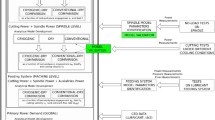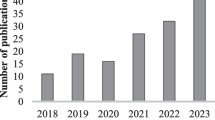Abstract
In the field of machining difficult-to-cut materials like titanium or nickel-based alloys, the use of high-pressure cooling lubricant supply (HPCLS) offers huge potential to significantly increase productivity and process stability. Due to enhanced cooling and lubrication of the cutting zone, tool wear can be decreased which allows higher applicable cutting speeds. Furthermore, process stability can be increased through effective chip breaking and evacuation. Increasing energy prices and legislative framework conditions, require energy efficient machine tools and processes. Since additional energy is required to run the high-pressure pump, it has to be determined if the overall process is still energy-efficient due to the increase in productivity resulting in shorter cycle times. In this paper the overall aim is to evaluate the conventional-flood-cooling and HPCLS in terms of economics and energy efficiency. Therefore a case study has been performed in which the energy consumption and production times for machining a rotationally symmetric jet engine part made of Inconel 718 were compared for both conventional and HPCLS. Furthermore, an ecological evaluation has been conducted to determine the advantageousness of the HPCLS. Due to the rising necessity of suppliers to provide a product carbon footprint, a methodology for assessing the footprint has been applied.
Similar content being viewed by others
Abbreviations
- HPCLS:
-
High-Pressure Cooling Lubricant Supply
- CoC:
-
Conventional Cooling
- HPP:
-
High-Pressure Pump
- HP:
-
High-Pressure
- P:
-
Energy consumption [kW]
- p:
-
lubricant supply pressure [bar]
- Q:
-
lubricant flow rate [l/min]
References
Ezugwu, E. O., “Key Improvements in the Machining of Difficult-to-Cut Aerospace Superalloys” International Journal of Machine Tools and Manufacture, Vol. 45, No. 12, pp. 1353–1367, 2005.
Dudzinski, D., Devillez, A., Moufki, A., Larrouquere, D., Zerrouki, V., and Vigneau, J., “A Review of Developments Towards Dry and high Speed Machining of Inconel 718 Alloy” International Journal of Machine Tools and Manufacture, Vol. 44, No. 4, pp. 439–456, 2004.
Choudhury, I. A. and El-Baradie, M. A., “Machinability of Nickelbase Super Alloys: a General Review” Journal of Materials Processing Technology, Vol. 77, No. 1, pp. 278–284, 1998.
Kara, S. and Li, W., “Unit Process Energy Consumption Models for Material Removal Processes” CIRP Annals-Manufacturing Technology, Vol. 60, No. 1, pp. 37–40, 2011.
Grass, P., “Hochdruckkühlung erschließt Produktivitätsreserven” VDI-Z, Vol. 145, No. 5, pp. 76–79, 2003.
Klocke, F., Sangermann, H., Krämer, A., and Lung, D., “Influence of a high-Pressure Lubricoolant Supply on Thermo-Mechanical Tool Load and Tool Wear behaviour in the Turning of Aerospace Materials” Proc. of the Institution of Mechanical Engineers, Part B: Journal of Engineering Manufacture, Vol. 225, No. 1, pp. 52–61, 2011.
Klocke, F., “Prozessoptimierung-Automatisierte Produktion-ohne Spanbruch undenkbar” ZWF: Zeitschrift für Wirtschaftlichen Fabrikbetrieb, Vol. 105, No. 1, pp. 21–25, 2010.
Kaminski, J. and Alvelid, B., “Temperature Reduction in the Cutting Zone in Water-Jet Assisted Turning” Journal of Materials Processing Technology, Vol. 106, No. 1, pp. 68–73, 2000.
Pigott, R. J. S. and Colwell, A. T., “Hi-Jet System for Increasing Tool Life” SAE, Paper No. 520254, 1952.
Ng, E. G., Lee, D. W., Sharman, A. R. C., Dewes, R. C., Aspinwall, D., and Vigneau, J., “High Speed Ball Nose end Milling of Inconel 718” CIRP Annals-Manufacturing Technology, Vol. 49, No. 1, pp. 41–46, 2000.
De Lacalle, L. L., Perez-Bilbatua, J., Sanchez, J., Llorente, J., Gutierrez, A., and Alboniga, J., “Using High Pressure Coolant in the Drilling and Turning of Low Machinability Alloys” The International Journal of Advanced Manufacturing Technology, Vol. 16, No. 2, pp. 85–91, 2000.
Sørby, K. and Tønnessen, K., “High-Pressure Cooling of Face-Grooving Operations in Ti6Al4V” Proc. of the Institution of Mechanical Engineers, Part B: Journal of Engineering Manufacture, Vol. 220, No. 10, pp. 1621–1627, 2006.
Crafoord, R., Kaminski, J., Lagerberg, S., Ljungkrona, O., and Wretland, A., “Chip Control in Tube Turning using a High-Pressure Water Jet” Proc. of the Institution of Mechanical Engineers, Part B: Journal of Engineering Manufacture, Vol. 213, No. 8, pp. 761–767, 1999.
Ezugwu, E. O. and Bonney, J., “Effect of High-Pressure Coolant Supply when Machining Nickel-base Inconel 718, Alloy with Coated Carbide Tools” Journal of Materials Processing Technology, Vol. 153, pp. 1045–1050, 2004.
Kaminski, J., Ljungkrona, O., Crafoord, R., and Lagerberg, S., “Control of Chip Flow Direction in High-Pressure Water Jet-Assisted Orthogonal Tube Turning” Proc. of the Institution of Mechanical Engineers, Part B: Journal of Engineering Manufacture, Vol. 214, No. 7, pp. 529–534, 2000.
Sharman, A. R. C., Hughes, J. I., and Ridgway, K., “Surface Integrity and Tool Life when Turning Inconel 718 using Ultra-High Pressure and Flood Coolant Systems” Proc. of the Institution of Mechanical Engineers, Part B: Journal of Engineering Manufacture, Vol. 222, No. 6, pp. 653–664, 2008.
Dahlman, P., “A Comparison of Temperature Reduction in High-Pressure Jet-Assisted Turning using High Pressure Versus High Flowrate” Proc. of the Institution of Mechanical Engineers, Part B: Journal of Engineering Manufacture, Vol. 216, No. 4, pp. 467–473, 2002.
Mazurkiewicz, M., Chow, J., and Kubala, Z., “Metal Machining with High-Pressure Water-Jet Cooling Assistance-a New Possibility” Journal of Engineering for Industry, Vol. 111, No. 1, pp. 7–12, 1989.
Braham-Bouchnak, T., Germain, G., Robert, P., and Lebrun, J.-L., “High Pressure Water Jet Assisted Machining of Duplex Steel: Machinability and Tool Life” International Journal of Material Forming, Vol. 3, No. 1, pp. 507–510, 2010.
Habak, M., Lebrun, J. L., Waldmann, S., Robert, P., and Fischer, C., “Residual Stress in High-Pressure Water Jet Assisted Turning of Austenitic Stainless Steel” Proc. of Materials science forum, Vol. 524–525, pp. 581–586, 2006.
Machado, A. R. and Wallbank, J., “The Effects of a High-Pressure Coolant Jet on Machining” Proc. of the Institution of Mechanical Engineers, Part B: Journal of Engineering Manufacture, Vol. 208, No. 1, pp. 29–38, 1994.
Ezugwu, E. O., Machado, A. R., Pashby, I. R., and Wallbank, J., “The Effect of High-Pressure Coolant Supply When Machining a Heat-Resistant Nickel-Based Superalloy” Lubrication Engineer, Vol. 47, pp. 751–757, 1990.
ISCAR Germany GmbH, “Effizienz im Schneidprozess und Hochdruckkühlschmierung bei der Bearbeitung von Sonderwerkstoffen”, Fräsen + Bohren, pp. 32–37, 2010.
Klocke, F. and König, W., “Fertigungsverfahren 1: Drehen, Fräsen, Bohren” Springer, 7th Ed., 2002.
MatWeb., “Special Metals INCONEL® Alloy 718” http://www.matweb.com/search/datasheettext.aspx?matguid=94950a2d209040a09b89952d45086134.html (Accessed 20 MAY 2014)
Ezugwu, E. O., Wang, Z. M., and Machado, A. R., “The Machinability of Nickel-based Alloys: a Review” Journal of Materials Processing Technology, Vol. 86, No. 1, pp. 1–16, 1998.
Ezugwu, E. O., Da Silva, R. B., Bonney, J., and Machado, A. R., “Evaluation of the Performance of CBN Tools when Turning Ti-6Al-4V Alloy with High Pressure Coolant Supplies” International Journal of Machine Tools and Manufacture, Vol. 45, No. 9, pp. 1009–1014, 2005.
Klocke, F. and König, W., “Fertigungsverfahren 1: Drehen, Fräsen, Bohren (VDI-Buch)” Springer, 8th Ed., pp. 345–359, 2008.
Sangermann, H., “Hochdruck-Kühlschmierstoffzufuhr in der Zerspanung” Apprimus-Verlag, pp. 143–153, 2013.
Gabi Software, “GaBi Databases 2006” http://database-documentation.gabi-software.com/support/gabi/.html (Accessed 20 MAY 2014)
Author information
Authors and Affiliations
Corresponding author
Rights and permissions
About this article
Cite this article
Klocke, F., Lung, D., Cayli, T. et al. Evaluation of energy efficiency in cutting aerospace materials with high-pressure cooling lubricant supply. Int. J. Precis. Eng. Manuf. 15, 1179–1185 (2014). https://doi.org/10.1007/s12541-014-0454-2
Received:
Revised:
Accepted:
Published:
Issue Date:
DOI: https://doi.org/10.1007/s12541-014-0454-2




